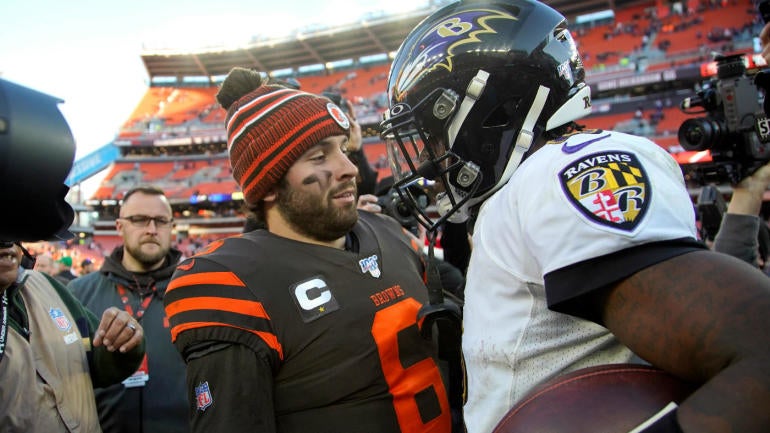
For the first time in quite a long time, the Cleveland Browns are firmly in playoff position late in the season. On Monday night, they look to further establish their postseason worthiness as they host the division rival Baltimore Ravens on Monday Night Football.
The Browns are now 9-3 after taking out the Tennessee Titans last week, while the Ravens are 7-5 after having stopped a three-game losing skid by throttling the Dallas Cowboys in Lamar Jackson's return from the COVID-19 list. Baltimore is currently on the outside of the playoff picture looking in, and a divisional victory on Monday evening would go a long way toward giving them a leg up in the hunt for one of the wild card spots.
Without further ado, let's break down the matchup.
How to watch
Date: Monday, Dec. 14 | Time: 8:15 p.m. ET
Location: FirstEnergy Stadium (Cleveland)
TV: ESPN | Stream: fuboTV (try for free)
Follow: CBS Sports App
When the Ravens have the ball
The Ravens' running game bounced back in a big way last week. Lamar Jackson, J.K. Dobbins, Gus Edwards, and Mark Ingram combined for a ridiculous 37 carries for 294 yards and two touchdowns against Dallas, including five runs of 20 yards or more. They controlled the entire game, to the point that Jackson barely had to throw the ball at all. Of course, everybody can run on the Cowboys. (Except for the Bengals, apparently.) Racking up those types of figures against the Browns is a different challenge altogether.
But the Ravens know all about how to do that, too. They detonated against the Browns all the way back in Week 1. They rushed 30 times for 111 yards and two scores, plus Jackson completed 20 of his 25 passes for 275 yards and three additional touchdowns. They won 38-6 and honestly, the game didn't feel that close.
But the two teams have changed quite a bit since then. Cleveland's defense has stiffened considerably, despite a few blow-up games along the way. The line -- when Myles Garrett is healthy -- is among the most impactful defensive fronts in the league. The Baltimore offense has been just a bit off for most of the year, especially the aerial attack. Jackson's deep passing has taken a step backward this season, and that backward step has had a cascading effect on the rest of the offense's performance.
That said, there are reasons why the Ravens were able to so thoroughly dominate the Browns back in Week 1. Their offense is built to attack a defense like Cleveland's. Greg Roman's use of heavy formations forces more linebackers and safeties onto the field, which Baltimore can then attack with Jackson's speed on the perimeter, Mark Andrews' athleticism over the middle, and Marquise Brown's ability to take the top off the defense.
The Browns are an analytically-inclined organization and prefer to devote their resources to edge rushers and corners, not linebackers and/or safeties. That provides a big opportunity for Andrews, who will make his return from the COVID-19 list for this game. He had five catches for 58 yards and two touchdowns back in Week 1, plus 4-31-1 and 6-93-2 in two matchups with Cleveland last season. He is perfectly suited to exploit this defense, and the Ravens seemingly know exactly how to get him involved.
The key to neutering his impact is that Cleveland defensive front dominating its matchup with Baltimore's offensive line. Luckily for Cleveland, the Ravens have gotten worse up front this year. Marshal Yanda retired in the offseason, and Ronnie Stanley was lost for the year back in Week 8. If Myles Garrett, Larry Ogunjobi, Olivier Vernon, and company can get after Jackson and force him into uncomfortably quick decisions, they stand a chance of making this more of a slow-paced, low-scoring game, which is their best chance to win in this particular matchup.
When the Browns have the ball
The Browns caught a nice break having an extra day of rest for this game, which allowed them to activate offensive lineman Wyatt Teller for the festivities. All three of Teller, J.C. Tretter, and Jack Conklin will be active for the game, ensuring that the Browns are at full strength up front. That unit is the strength of their team, so it's quite important to have all three good to go.
Like Baltimore, Cleveland wants to base its offense around the run game; but the two teams go about it in slightly different ways. Baltimore uses varied formations, personnel groupings, alignments, a rotating cast of running backs, and the threat of Jackson scooting downfield to gash opponents with a power running game. Cleveland mostly operates out of one- or two-tight end sets, utilizing a zone blocking scheme to create creases for Nick Chubb and/or Kareem Hunt to stick their foot in the ground, cut upfield, and zoom through the heart of the defense.
That strategy has worked out quite while for the Browns. Cleveland ranks fifth in Football Outsiders' Adjusted Line Yards per carry, plus second in open-field yards and first in second-level yards. They've struggled a bit with runs getting stopped at or behind the line of scrimmage (19.1 percent), but offset that with 35 explosive rushing gains, per PFF and Tru Media, the eighth-highest mark in the league despite their having played one fewer game than most teams on the leaderboard.
Baltimore's run defense is strong (fourth in DVOA), though, and even more so when Calais Campbell and Brandon Williams are healthy enough to join Derek Wolfe up front, as will be the case again on Monday night. The Browns, then, would do well to lean on their play-action passing game.
Baker Mayfield has lit it up in two consecutive games, completing 44 of 62 passes for 592 yards, six touchdowns, and zero interceptions. On the season, he's a far better passer after first faking a run than he is on a straight dropback, seeing his passer rating spike from 85.4 to 121.9 with the aid of a play-action fake. It's not uncommon for quarterbacks to be better on play-action than without it, but Mayfield's split is wider than most. The same is true of passes against the Ravens. Baltimore has allowed an 80.7 rating on straight dropbacks, per PFF and Tru Media, compared with 110.7 after play fakes.
It's always dangerous to fake the run against Baltimore, though, because the Ravens are ultra-aggressive when it comes to bringing blitzes. They have faced only 97 play-action dropbacks this year, and their 41.3 percent blitz rate is likely a huge contributing factor. If the opponent sends extra rushers after the quarterback and you're wasting time faking a running play before delivering the ball, you're more likely to be sacked. And you can't have that against this team.
Mayfield also happens to be A. one of the most heavily-blitzed passers in the league (33.8 percent, per PFF and Tru Media, sixth out of 35 qualifiers); and B. extremely conservative when throwing against blitzes. Baltimore bringing heavy pressure could force Cleveland to continue checking the ball down, working methodically down the field. That works fine against some defenses, but with Mayfield throwing against the Ravens' pick-happy secondary, things could get a little dicey. That's especially true of Jarvis Landry, emerging of late as a true No. 1 option, gets shadow coverage from Marlon Humphrey, forcing Mayfield to look to guys like Rashard Higgins, Khadarel Hodge, and his tight ends (with no Austin Hooper) more often.
Prediction: Ravens 23, Browns 20

















